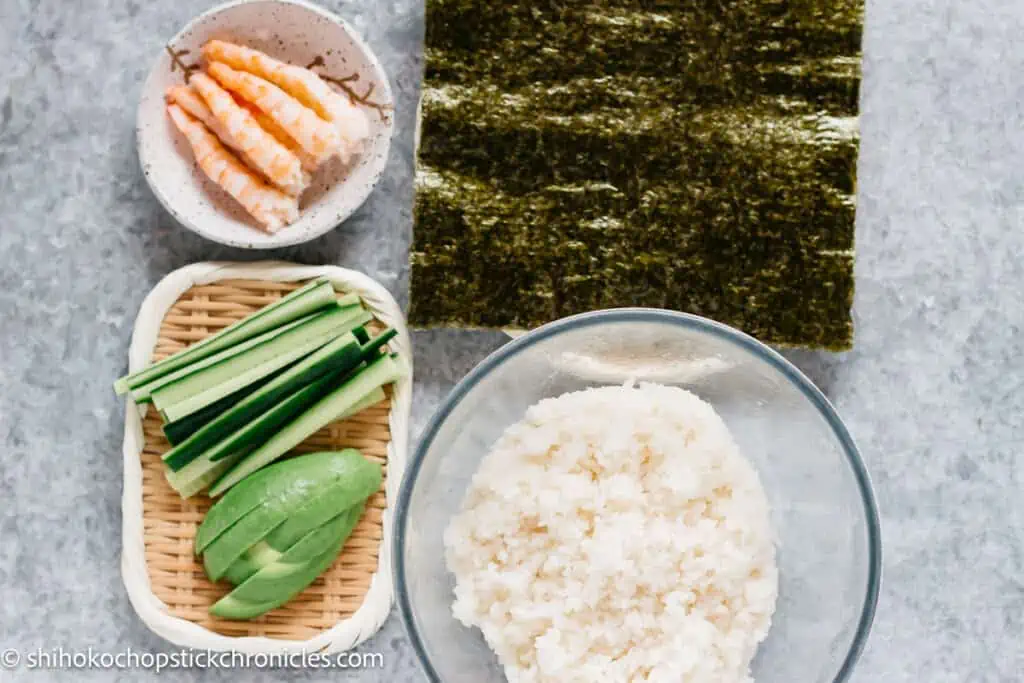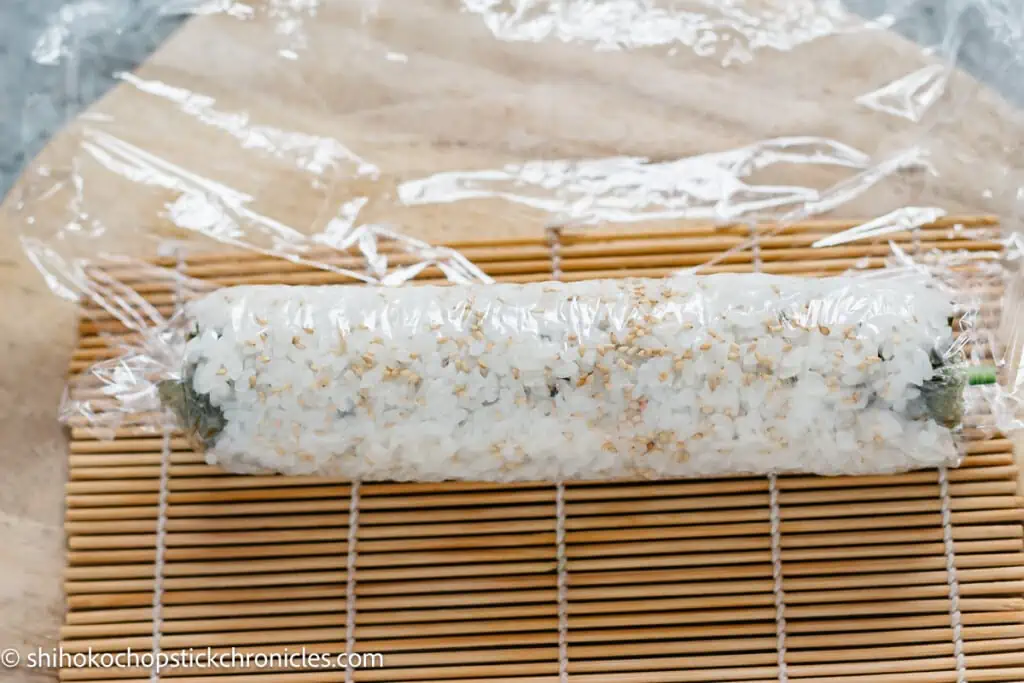Uramaki are a type of sushi roll recognisable by their inside-out appearance. They’re fresh and delicious and are easy to make at home!
Uramaki, also known as inside-out sushi rolls, are a popular and well-known type of sushi. Characterised by having the rice on the outside and nori (seaweed) on the inside, this sushi offers a unique twist to traditional rolls and allows for a variety of fresh ingredients to be placed both in and on top of the sushi pieces! With endless possibilities for creativity and flavour combinations, uramaki will be a hit with everyone.
What is Uramaki?
Uramaki, or “inside-out roll”, is a type of sushi roll that originated in Japan. Unlike traditional maki rolls where the seaweed is on the outside, uramaki has the rice on the outside and the seaweed (nori) on the inside.
The word “uramaki” translates to “reverse roll” in English, referring to how this sushi roll reverses the order of ingredients. The process involves spreading a thin layer of sushi rice onto a sheet of nori and then flipping it over to add various fillings such as fish and vegetables. Once the fillings are added, it is rolled tightly using a bamboo mat called a makisu. Because the rice is on the outside, extra ingredients and toppings can be placed on top of the rolls to add extra elements for flavour and appearance. A few well-known types of uramaki outside of Japan are California roll, Philadelphia roll, and Dragon roll.
One of the primary reasons for creating uramaki was to cater to Western palates that were initially hesitant about consuming unfamiliar ingredients such as raw fish (sashimi) and nori seaweed. These ingredients are very visible on other sushi variations like regular maki rolls and nigiri. So by hiding the seaweed inside and having rice on the outer layer, it became more visually appealing and easier to eat for those who were not accustomed to traditional sushi.


Ingredients to Make Uramaki
1. Sushi Rice: short-grain rice that has been seasoned with rice vinegar, salt, and sugar.
2. Nori (Seaweed Sheets): thin sheets of seaweed used to wrap around the sushi roll.
3. Fillings: Uramaki offers endless possibilities when it comes to fillings. Some popular options include avocado, cucumber, crab meat, tempura shrimp, spicy tuna mixtures, or even cream cheese for added richness. These ingredients can be combined creatively to create unique flavour profiles. Here are some ingredients suggestions that you can use at home:
– Protein:
- Fresh Fish: sashimi-grade salmon, tuna, yellowtail, or shrimp.
- Cooked Seafood: crabmeat (real and imitation), shrimp tempura, bbq eel, cooked salmon, canned tuna.
- Vegetarian Proteins: seasoned tofu, tempura vegetables, or grilled vegetables like eggplant or zucchini.
– Vegetables:
- Avocado: this works well with fish and seafood.
- Cucumber: Provides a refreshing crunch.
- Carrots: Thinly sliced or julienned carrots add vibrant color, texture, and subtle sweetness.
4. Condiments/Sauces: –
- Soy Sauce
- Wasabi: Japanese spicy horseradish paste.
- Pickled Ginger (Gari): Usually served alongside sushi rolls as a palate cleanser between bites.
- Mayonnaise: outside of Japan, Japanese mayonnaise is commonly mixed with other sauces like spicy mayo or sriracha for uramaki rolls.
5. Optional Extras:
- Sesame Seeds: a sprinkle of toasted sesame seeds over the rice can add a hint of nutty flavor and provide an appealing texture.
- Tobiko (Flying Fish Roe): Small, flavourful fish eggs that add a burst of brininess and color to the rolls.
These are just some suggestions for uramaki fillings. Feel free to experiment with other ingredients you come up with.
How to Make Uramaki at Home Step-by-Step Instructions
Prepare the Sushi Rice : follow my perfect sushi rice recipe here.
Assemble Your Fillings
- Slice your chosen fillings into thin strips or matchstick-sized pieces.
- Keep them separate and organized on a plate for easy access during rolling.
Roll Your Uramaki Rolls
- Lay out your bamboo sushi mat on a clean kitchen bench.
- Place a plastic wrap or cling film over the bamboo mat to prevent sticking.
- Place one sheet of nori onto your prepared mat with the shiny side facing down.
- Take about a cup of prepared sushi rice and evenly spread it over two-thirds of the nori sheet’s surface while leaving about an inch uncovered at one end with wet hands.
- Flip the nori seaweed and sushi rice over.
- Arrange your desired fillings in a horizontal line across the center of the rice.
- Using the sushi mat, start rolling the nori sheet tightly from the bottom edge, applying gentle pressure to keep everything together.
Slice and Serve. With a sharp knife, slice each roll and serve with condiments.
Creating delicious and visually appealing uramaki sushi rolls at home requires the right tools.
Sushi Mat (Makisu): The first tool every aspiring sushi chef needs is a bamboo sushi mat or “makisu.” This flexible mat is used to roll and shape the nori (seaweed) sheets around the filling. It provides an even pressure during rolling, ensuring tight and well-formed rolls. Look for mats made from high-quality bamboo that are sturdy and easy to clean.
Plastic Wrap/Cling Film: Using plastic wrap or cling film not only maintains cleanliness but also helps prevent sticking when shaping uramaki sushi rolls on your bamboo mat. Place the plastic wrap over the sushi mat before rolling.
Sharp Knife: A very sharp knife is essential for cutting the ingredients and the finished uramaki sushi rolls neatly. Opt for a sashimi knife or a traditional Japanese yanagiba knife with a long, thin blade specifically designed for slicing raw fish or vegetables with precision. A sharp knife also ensures clean cuts without squishing or tearing the ingredients.
Tips for successful rolling Uramaki
- Choose fresh ingredients that complement each other well. Popular options include avocado slices, cucumber sticks, crabmeat or imitation crab, smoked salmon strips, tuna chunks or sashimi-grade fish cuts.
- When adding fillings onto the nori sheet, remember not to overcrowd them centrally; otherwise it becomes difficult to roll tightly without spilling out ingredients from both ends—leaving about an inch margin on all sides is ideal.
- When rolling uramaki, apply gentle pressure using the sushi mat to ensure a tight roll without any air gaps. Gradually tighten the roll as you go, keeping an eye on evenness and maintaining firmness throughout.
- Use a sharp knife when cutting the finished rolls and wipe the knife carefully between cuts to ensure the pieces are clean and not squished or falling apart.
FAQ
A : The main difference between maki and uramaki rolls is the placement of the rice and seaweed. Regular maki rolls have the seaweed on the outside with various fillings inside, while uramaki rolls reverse this by having rice on the outside with seaweed inside.
A : Uramaki sushi typically contains raw fish or seafood. However there are some that use cooked ingredients or only vegetables (making it suitable for people who are vegan/vegetarian).


Uramaki
Uramaki are a type of sushi roll recognisable by their inside-out appearance. They’re fresh and delicious and are easy to make at home!
Servings: 2 rolls
Calories: 480kcal
Instructions
Preparing fillings
-
Cut the cucumber like long matchsticks.
-
Slice the avocado to a similar size to the cucumber.
-
Peel and devein prawns and push on to bamboo skewers.
-
Cook the prawns in boiling water till the colour of prawn changes from transparent to whitish colour (about a minute).
-
Turn the heat off and remove the prawn skewers from the cooking pot.
-
Cool the prawns then remove the skewers.
-
Cut ⅓ off the nori seaweed sheet and use the ⅔ of the sheet. *2
Rolling Uramaki
-
Place a sheet of cling wrap over a bamboo rolling mat.
-
Place the ⅔ of nori seaweed sheet on the cling wrap. *2
-
Place a cup of sushi rice on the nori sheet and spread it evenly and thinly with wet hands.
-
Fold over the other half of the cling wrap and holding the ends of the cling wrap together to flip it over.
-
Spread mayonnaise on the the centre of the nori seaweed.
-
Layout cooked prawns, cucumbers, and avocado over the mayonnaise.
-
With both hands, pinch the edge of the bamboo mat and rest of the fingers holding down the fillings as you roll the mat.
-
When it is completely rolled, give it a gentle squeeze with your both hands.
-
Slice the uramaki roll with a sharp knife and serve on a plate with condiments of your choice and a small bowl of soy sauce.
Notes
*2 left over nori seaweeds can be used for wrapping onigiri later.
*3 Sushi rice – see recipe here.
Nutrition
Calories: 480kcal | Carbohydrates: 89g | Protein: 9g | Fat: 10g | Saturated Fat: 2g | Polyunsaturated Fat: 2g | Monounsaturated Fat: 6g | Cholesterol: 18mg | Sodium: 86mg | Potassium: 449mg | Fiber: 7g | Sugar: 2g | Vitamin A: 283IU | Vitamin C: 8mg | Calcium: 117mg | Iron: 3mg


















